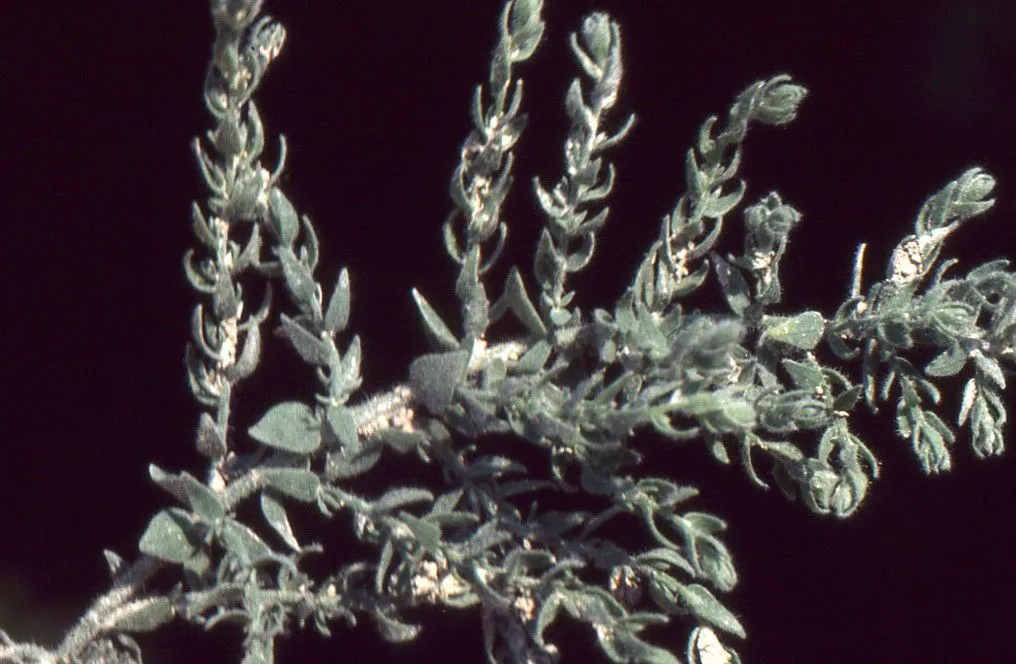
Author: L.
Bibliography: Sp. Pl.: 223 (1753)
Year: 1753
Status: accepted
Rank: species
Genus: Cressa
Vegetable: False
Observations: Medit. to Africa, W. & C. Asia to Indian Subcontinent
Rosin weed, known scientifically as Cressa cretica, is an intriguing member of the Convolvulaceae family, initially described in 1753. This resilient and versatile plant has adapted to a wide range of habitats, extending its presence from the Mediterranean region to Africa, and from Western and Central Asia to the Indian subcontinent.
Characterized by its hardy nature, Cressa cretica thrives in arid and semi-arid climates, often found in saline environments where other flora might struggle to survive. Its ability to flourish in such challenging conditions makes it a key species in understanding plant resilience and adaptation.
The rosin weed bears small, dense clusters of white flowers, which contribute to its appeal and aid in its identification. These blossoms, though not overly conspicuous, are vital for the plant’s reproduction and the sustenance of local pollinator populations. The foliage is typically covered in fine, silvery hairs, providing a distinctive texture and aiding in moisture retention—a crucial adaptation for survival in its native dry habitats.
Historically, Cressa cretica has been utilized in various traditional medicine practices. Its leaves and extracts have been reputed for their therapeutic properties, although modern scientific validation of these uses is still an ongoing process. The plant’s role in traditional remedies underscores its importance to indigenous communities and the necessity of preserving such knowledge.
In conclusion, Rosin weed, or Cressa cretica, stands as a remarkable example of botanical endurance and adaptability. Its widespread distribution across diverse and often harsh environments highlights its ecological significance and the intricate balance of ecosystems where it plays a role. Understanding and appreciating this resilient species not only enriches our knowledge of plant biology but also emphasizes the broader narrative of survival and adaptation in the natural world.
Eng: cretan alkaliweed
Deu: rudravanti
Fra: cressa de crète
Ara: meliah
En: Rosin weed, Cretan Alkaliweed, Rosin Weed
Ar: مليح (مُلّيح، مِلِّيح)، مليخ (مِلِّيخ), ندوه (نَدْوه)، ابو حصابه (أبو حُصابه)، سبخ (سِبَخ), ندوة كريتية, Meliah
Bg: Критска креса
Fi: Suolakarakki
Fr: Cressa de Crète, Cresse de Crète
De: Rudravanti, Kretische, Salzkresse
He: ערר כרתי
It: Cressa
Ml: അഴുകണ്ണി
: Cretan alkaliweed
© copyright of the Board of Trustees of the Royal Botanic Gardens, Kew.
© copyright of the Board of Trustees of the Royal Botanic Gardens, Kew.
© copyright of the Board of Trustees of the Royal Botanic Gardens, Kew.
Taken Sep 17, 1999 by Tela Botanica − Liliane ROUBAUDI (cc-by-sa)
Taken Apr 13, 2018 by Tela Botanica − Liliane ROUBAUDI (cc-by-sa)
Taken Apr 13, 2018 by Tela Botanica − Liliane ROUBAUDI (cc-by-sa)
Taken Apr 13, 2018 by Tela Botanica − Liliane ROUBAUDI (cc-by-sa)
Taken Apr 13, 2018 by Tela Botanica − Liliane ROUBAUDI (cc-by-sa)
Taken Aug 16, 2020 by Bastide Margarido (cc-by-sa)
Taken Apr 10, 2022 by Bryan Girard (cc-by-sa)
Taken Apr 10, 2022 by Bryan Girard (cc-by-sa)
Taken Aug 15, 2014 by Photoflora – Benoit BOCK (©)
Taken Sep 17, 1999 by Tela Botanica − Liliane ROUBAUDI (cc-by-sa)
Taken Aug 15, 2014 by Photoflora – Benoit BOCK (©)
Taken Sep 10, 2011 by Tela Botanica − Bertrand BUI (cc-by-sa)
Taken Aug 4, 2017 by Tela Botanica − Genevieve BOTTI (cc-by-sa)
Taken Aug 4, 2017 by Tela Botanica − Genevieve BOTTI (cc-by-sa)
Taken Apr 13, 2018 by Tela Botanica − Liliane ROUBAUDI (cc-by-sa)
Taken Jun 3, 2006 by Tela Botanica − Liliane Roubaudi (cc-by-sa)
Taken Jul 13, 2006 by Tela Botanica − Christophe BERNIER (cc-by-sa)
Taken Jun 23, 2011 by Tela Botanica − Bertrand BUI (cc-by-sa)
Taken Jul 13, 2006 by Tela Botanica − Christophe BERNIER (cc-by-sa)
Taken Jun 23, 2011 by Tela Botanica − Bertrand BUI (cc-by-sa)
Taken Nov 11, 2022 by M. Hedayat (cc-by-sa)
Taken Oct 23, 2022 by M. Hedayat (cc-by-sa)
Taken Nov 11, 2022 by M. Hedayat (cc-by-sa)
Taken Oct 23, 2022 by M. Hedayat (cc-by-sa)
Taken Oct 15, 2011 by Photoflora – Jean-Luc TASSET (©)
Ph maximum: 8.0
Ph minimum: 7.5
Light: 8
Atmospheric humidity: 8
Soil nutriments: 7
Soil salinity: 8
Family: Myrtaceae Author: (F.Muell.) K.D.Hill & L.A.S.Johnson Bibliography: Telopea 6: 402 (1995) Year: 1995 Status:…
Family: Rubiaceae Author: Pierre ex A.Froehner Bibliography: Notizbl. Bot. Gart. Berlin-Dahlem 1: 237 (1897) Year:…
Family: Sapindaceae Author: Koidz. Bibliography: J. Coll. Sci. Imp. Univ. Tokyo 32(1): 38 (1911) Year:…
Family: Asteraceae Author: A.Gray Bibliography: Pacif. Railr. Rep.: 107 (1857) Year: 1857 Status: accepted Rank:…
Family: Fabaceae Author: Medik. Bibliography: Vorles. Churpfälz. Phys.-Ökon. Ges. 2: 398 (1787) Year: 1787 Status:…
Family: Aspleniaceae Author: (Cav.) Alston Bibliography: Bull. Misc. Inform. Kew 1932: 309 (1932) Year: 1932…